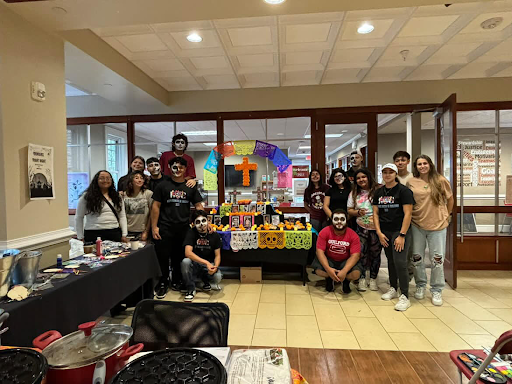I walked into a strange world: figures carved into branches, cubes of water connected by tubes, vast paintings depicting mythical creatures, a contraption composed of an assortment of mallets, bass drums and what can only be described as a pink tuft from a Truffula tree.
This is the strange world of art.
On Feb. 24, associate professor and chair of the art department Kathryn Shields, along with Terry Hammond, director of the art gallery, hosted “Art After Guilford.” This annual event included a panel of faculty artists and recent Guilford graduates pursuing careers in art. A motivational atmosphere surrounded the well-attended afternoon of events.
Beginning with a question-and-answer session, students asked professors about their journeys with art. Maia Dery, instructor of art, responded to a question from the audience on finding inspiration for her work.
“The answer is always right there, but sometimes you have to tear the piece up to get to it,” she said.
Assistant Professor of Art Mark Dixon ’96 agreed but expanded with an anecdote.
“Most of my ideas are from misunderstandings,” he said. “Once (in college), we locked ourselves in a room and turned a bicycle into a record player.”
The faculty panel was succeeded by an informal gathering in the Hege-Cox building. Upon arrival, four students, perched atop stools on the balcony, enjoyed the sunset as they etched, drew and retouched their artistic pieces.
“This is my ideal work place,” said junior Iain Parrott as he stared across the quad. A mystical sense of raw inspiration permeates Hege-Cox, especially as artists mingle and discuss their experiences with certain mediums and engage in passionate conversations about the vast ground the word “art” itself encompasses.
Fueled by pizza and refreshments, an audience whose size likely violated fire safety standards crowded into the presentation room to hear Guilford alumni speak about their experiences in art.
Bryan Stacy ’09, Scott Lyman ’08 and Lindsay Emery ’14 captivated the audience with film, stories and struggles in the world of art after Guilford. Stacy, who owns the tattoo parlor Anvil and Ink in Wilmington, discussed transition.
“You’re basically turning yourself into a business,” he said. Emery, who founded handmade tableware project Suite One Studios, agreed. “Finding where your passion is, that’s huge,” she said. “You’re figuring out who you are, and it can be damaging to get caught up in someone else’s momentum.”
Even after Guilford, graduates find themselves thankful for that one business course they took or the focus Guilford places on social justice. Lyman, who returned recently from a film project in London, strives to create art that has meaning and presence.
“Anything can be art,” he said. “But how do you make this painting for social justice?”
The rise of such questions is a sign that Guilford has effectively imbued values like social justice into its graduates.
This combination is vital in a society where art is often seen as a hobby rather than a profession. Junior and art major Colin Nollet has encountered this perception numerous times.
“As an art major, … I get that a lot,” he said. “I literally had someone who was like, ‘Do you have time to switch majors?’ I also feel like art can give you a lot of skills, … and you can be better at other things because you taught yourself to be better at art.”
For art majors like Nollet, employment directly out of college may not be the sole objective. “I’m not just trying to get a job. … I’m trying to be successful and thrive in life,” he said.
Art After Guilford encouraged art students while opening the doors for others to the strange and beautiful world of art.





